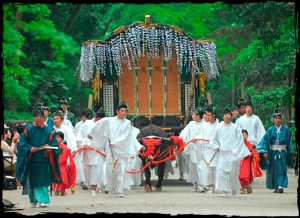ホーム > エンターテイメント一覧へ >
ホーム > エンターテイメント一覧へ >

There are two parts to Aoi Matsuri: the procession and the shrine rites.The procession is led by the Imperial Messenger. Following the imperial messenger are: two oxcarts, four cows, thirty-six horses, and six hundred people. All of which are dressed in traditional Heian period apparel decorated with aoi leaves.
The procession starts at 10:30 on May 15 and leaves the Kyoto Imperial Palace and slowly works its way towards the Shimogamo shrine and finally the Kamigamo shrine.
When they finally arrive at both shrines, the Saiō-Dai and Imperial Messenger perform their rituals. The Saiō-Dai simply pays her respects to the deities and the Imperial Messenger intones the imperial rescript praising the deities and requesting their continued favor.
There are two main figures in the Aoi Matsuri: the Saiō-Dai and the Imperial Messenger.The Saiō-Dai is a woman who is chosen from the sisters and daughters of the Emperor to dedicate herself to the Shimogamo shrine. The role of Saiō-Dai was to maintain ritual purity and to represent the Emperor at the festival. Now, the role of the Saiō-Dai is played by an unmarried woman in Kyoto. She is be dressed in the traditional style of the Heian court. Traditional Heian court dress for women would be wearing several layers of exquisitely colored silk robes.The Saiō-Dai wears twelve layers of the traditional style robes (jūnihitoe). To maintain ritual purity, the Saiō-Dai goes through several ceremonies of purification before the procession of the festival. The Imperial Messenger leads the festival procession on horseback. During the Heian period he would be a Fifth-Rank courtier holding the office of middle or lesser captain and was usually a man destined for high office. His role was to read the imperial rescript of the shrines and present the emperor’s offerings. During the Heian period, the Saiō-Dai and the Imperial messenger would be accompanied by ten dancers and twelve musicians.
Also featured at the Kamo no matsuri are horse races (kurabe-uma), and demonstrations of mounted archery (yabusame).
近隣情報